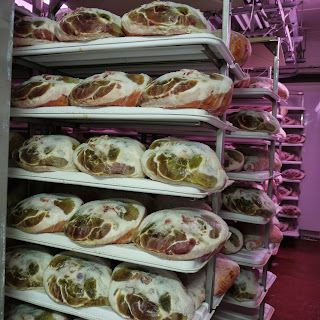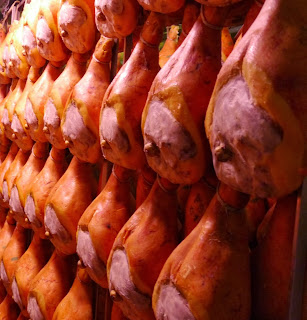Most Americans associate Italian food with pizza and pasta,
then Parmigiano Reggiano, Prosciutto and Balsamico. Unfortunately the poor imitations are what
you will find in most stores and restaurants.
My friend Kellie and I did a food valley tour in the region of Emilia
Romagna, basing ourselves in Parma a beautiful university town, and then went
out from there. Our friend Sara Dallacasagrande
was our guide for the tour, and she first took us to a family run producer of
Parmigiano Reggiano. It’s important to
realize that Parmigiano Reggiano is a cheese that is made according to traditional
methods, and anything labeled Parmigiano Reggiano has been approved by the
consortium in Parma. The milk has to
come from Parma (talking to you Argentina) They use the evening milk and the
morning milk from the cows, rennet and salt.
From one vat of milk they get two wheels of cheese. The cheese is then packed into molds, stamped
with its date, etc. then dried.
It goes
into a saline water bath, and is turned each day.
Then it is sent to the aging rooms. They call them the cheese cathedrals. Love that!
The consortium tests the cheese at different
aging stages, and when it is deemed to be the highest quality, it gets a stamp
burned into the side of it.
If the
cheese is good, but may have a few cracks or bubbles in the center, the
stamping is filed off, and this is sold at a lower price to the customer.
 |
| This is the "B" grade--nothing wrong except a few air bubbles within |
Other cheeses that don’t make the grade (but
are still delicious) have all the stamping filed off and look like this.
 |
| Stamp is totally filed off this one |
We were told that after 12 months the cheese
can be sold, but most customers want the cheese to be at least 24 to 30 months
old. You may see some that is sold as “stra
vecchio” or extra aged. We did a nice
tasting of the different ages of the cheese, and then were on our way to a
prosciutto producer.
Most prosciutto
producers don’t allow visitors, but this one was very accommodating. We were able to see the legs as they were
initially salted; there is a special prosciutto massager who works just the
right amount of salt into the raw legs.
The pigs are a hybrid of the black Parma pig and a white Berkshire; they grow big and fat, and can be grown outside the area of Parma, but must be slaughtered in Parma to be considered Prosciutto di Parma. The aging of prosciutto is what gives it its delicious flavor. When the prosciutto master uses a piece of cartilage from a horse to tests the sweetness of the meat, then it is deemed ready.
He sticks this into the fat, and into the meat and smells the aroma on the cartilage. Prosciutto is normally aged for 2 years, then sold and most of us know it from pannini or prosciutto e melone. All of this production is done by hand, nothing is done by machine, except the stamping of the prosciutto with a machine. Buying anything other than Italian traditionally made prosciutto is really buying something entirely different. The cost of the prosciutto is high because of the strict regulations, and controls, as well as the hand made product and the amount of aging.
The pigs are a hybrid of the black Parma pig and a white Berkshire; they grow big and fat, and can be grown outside the area of Parma, but must be slaughtered in Parma to be considered Prosciutto di Parma. The aging of prosciutto is what gives it its delicious flavor. When the prosciutto master uses a piece of cartilage from a horse to tests the sweetness of the meat, then it is deemed ready.
He sticks this into the fat, and into the meat and smells the aroma on the cartilage. Prosciutto is normally aged for 2 years, then sold and most of us know it from pannini or prosciutto e melone. All of this production is done by hand, nothing is done by machine, except the stamping of the prosciutto with a machine. Buying anything other than Italian traditionally made prosciutto is really buying something entirely different. The cost of the prosciutto is high because of the strict regulations, and controls, as well as the hand made product and the amount of aging.
We were then taken to a beautiful winery outside of Parma, where
we sampled typical products, Parmigiano, Prosciutto and salumis, tortelli, and
an amazing crumble cake which I’m hoping to replicate at some time.
The winery makes mostly sparkling wines, malvasia, lambrusco, and a sweet dessert wine. It was a gorgeous day, we sat and had a wonderful lunch, with a vista that was gorgeous of the surrounding hills.
The winery makes mostly sparkling wines, malvasia, lambrusco, and a sweet dessert wine. It was a gorgeous day, we sat and had a wonderful lunch, with a vista that was gorgeous of the surrounding hills.
Our last stop was Villa San Donnino to see
how the balsamico is made. Davide is a
welcoming guide, and showed us the difference between traditionally made
balsamic vinegar and balsamic vinegar or Modena. Balsamic vinegar of Modena (that $5.95 bottle
from the grocer) is usually red wine vinegar, caramel color and brown sugar
that is boiled down. Traditionally made
balsamic vinegar is made from either trebbiano grapes or lambrusco grapes grown
in Modena, and pressed.
Traditionally made balsamic vinegar should only be GRAPE JUICE, nothing
more.
It is then put into old barrels of varying woods, in an attic, or acetaia. Each year, the owner will transfer some of the previous years vinegar into the next barrel, and the consortium only tests the vinegar after 12 years.
So the investment in the vinegar is enormous, waiting longer than most wines to age, and then not knowing if the consortium will accept it at 12 years. If not, you wait till it does---so the first type of balsamico that you can buy that is traditionally made, is aged a minimum of 12 years. The next is aged a minimum of 25 years. What’s the difference? Complexity---the 12 year old is delicious on ice cream, strawberries, and as a finish for a salad, steak, or risotto. The 25 year old has a beautiful complexity that will compliment almost anything. You never heat traditionally made balsamic vinegar, it will lose its complexity. Some other types of true balsamic containing only grape juice that are sold, are called condimento, since they are only aged 8 years, and cannot be sold as traditionally made. These of course are much less expensive. A bottle of 25 year old with a gold seal will cost upwards of €120, the white label minimum 12 year old will cost upwards of €45. The difference between the traditionally made and the balsamic vinegar of Modena is night and day---the cheap imitation has none of the complexity and natural sweetness of the traditionally made. Davide then showed us his beautiful villa that has been in the family since the early 1900’s—it was beautiful frescoes and art deco accents, as well as gorgeous grounds.
It is then put into old barrels of varying woods, in an attic, or acetaia. Each year, the owner will transfer some of the previous years vinegar into the next barrel, and the consortium only tests the vinegar after 12 years.
So the investment in the vinegar is enormous, waiting longer than most wines to age, and then not knowing if the consortium will accept it at 12 years. If not, you wait till it does---so the first type of balsamico that you can buy that is traditionally made, is aged a minimum of 12 years. The next is aged a minimum of 25 years. What’s the difference? Complexity---the 12 year old is delicious on ice cream, strawberries, and as a finish for a salad, steak, or risotto. The 25 year old has a beautiful complexity that will compliment almost anything. You never heat traditionally made balsamic vinegar, it will lose its complexity. Some other types of true balsamic containing only grape juice that are sold, are called condimento, since they are only aged 8 years, and cannot be sold as traditionally made. These of course are much less expensive. A bottle of 25 year old with a gold seal will cost upwards of €120, the white label minimum 12 year old will cost upwards of €45. The difference between the traditionally made and the balsamic vinegar of Modena is night and day---the cheap imitation has none of the complexity and natural sweetness of the traditionally made. Davide then showed us his beautiful villa that has been in the family since the early 1900’s—it was beautiful frescoes and art deco accents, as well as gorgeous grounds.
Traditionally made Balsamic vinegar (approved by the consortium labeled DOP) can only be sold in these bottles. Anything else, is not traditionally made.
Our
full day tour was enlightening, and informative, but most of all it was
fun. Being out in the country, meeting
the producers and enjoying a day of food, wine and seeing new places is hard
to beat. I highly recommend this part of
Italy, Parma is beautiful, Bologna is the epi-center of Italian gastronomy, and
Modena is home to the worlds’ most delicious vinegar and Ferrari, what’s not to
love? Note: the initials DOP or DOC in a region denotes that it is a denomination of protected origin; expect to pay more for products with this seal, as they have been made according to strict guidelines instituted by the local consortium. As saying goes, better ingredients, make better food, and this is true no matter what the cuisine.

























Thank you Diane!!!! Come back to Parma and visit us soon, we will show you a lot more ;-)
ReplyDeleteAll the best from Sara Dallacasagrande, tour guide from Parma, Italy.
Agarwal packers and movers (DRS Group) always craves to serve clients in a more promising way. In pursuit of this goal, its relocation specialists keep learning new techniques at regular interval.
ReplyDeleteAgarwal packers and movers